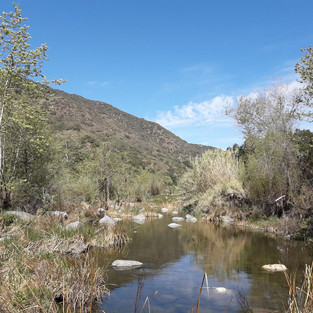Walking the Microclimates Along the Santa Margarita River
- Climate Science Alliance

- Jul 14, 2020
- 3 min read
Take a walk through the Santa Margarita River gorge with Drs. Megan Jennings and Isabel Rojas-Viada, as they work to map climate refugia as part of the Connecting Wildlands and Communities project.

In today's blog we are sharing a "Notes from the Field" entry written by Dr. Isabel Rojas-Viada, a researcher on Team Biodiversity for the Connecting Wildlands and Communities project. View the original posting from SDSU's Conservation Ecology Lab here.

In early Spring, Dr. Megan Jennings and I ventured through the Santa Margarita River gorge, within San Diego State University’s Ecological Reserve, named after the same river. Our task was to deploy temperature data loggers along and across the river, to monitor the gorge’s climates and map climate refugia, part of the project “Connecting Wildlands and Communities”.
Climate refugia are at the core of today’s conservation toolkit as they can protect species’ populations from anthropogenic climate warming, maintaining more stable climates than surrounding sites and having less exposure to extreme weather events like heat waves or droughts. To find these climate stable sites, we will quantify the rate of climate warming across the landscape and assess persistence and behavior of local weather events that alter the effect of regional climate warming. To meet our objectives, we are monitoring microclimates at the Santa Margarita Ecological Reserve to learn what weather events drive climate variability in our region and to adjust coarse scale maps that we are developing with other types of data.
On a misty, sunny morning, we launched our walk along the narrow, sinuous gorge. Our eyes were captured by an ever-changing river, with ponds and short rapids built from rocks of many shapes and colors. Along the river banks, we found riparian ecosystems of various kinds, from wetlands dominated by cattails and giant reeds, to small patches of oaks. Those oaks were gorgeous. By being a more mesic species, they are a sign that microclimates allowed their establishment. I really enjoyed looking at their form and color. They transported me way far south, to the mediterranean rivers in Chile. There, trees of the same color and size, with hard, evergreen, sclerophyllous leaves stand, sharing a similar river and the same sky. We also encountered some wild animals; we saw some of them, we heard others, and we spotted a few of them by the remains of their presence, their scat; enough to know they were close by.
Our walk continued for a long day. Without a trail and little references, we expected some challenges on your way. We crossed the river four times; so staying dry wasn’t easy. We also encountered a patch of prickly pear cactus blocking our way. We had two options, that spiny prickly pear patch or a rocky cliff. Fortunately, we didn’t have to choose one of those options, as Megan neatly cut a path through the patch. I’m not sure what we would have done without Megan’s gloves and knife. You must be prepared for everything when you are out there in the gorge! At the end, and after beating lots and lots of chaparral, we successfully deployed the loggers following our plan.
We will continue our climate monitoring in the Santa Margarita river. Stay tuned about project updates at “Connecting wildlands and communities”. I want to thank the managers of the reserve, Pablo Bryant and James Bourdon, for their support and facilitating our field trips. I acknowledge the contribution of project collaborators: Rebecca Lewison, Dan Cayan, Douglas Alden, Julie Kalansky, Alan and Lorraine Flint.
List of species:
Birds: Turkey Vulture, Red-tailed Hawk, American Coot, Acorn Woodpecker, Great Blue heron, Western Scrub-Jay, California Towhee, Yellow-rump Warbler, Common Yellow-throated warbler, Hooded Oriole, American Goldfinch, Wren spp, Mallard, Song Sparrow, American Crow, Pacific-slope Flycatcher, Northern Mockingbird, Anna’s Hummingbird, California Quail. Amphibians: California tree frog, Bullfrog Reptiles: Rattlesnake (heard but not seen, so species is unknown!), western fence lizard, whiptail lizard Mammals: Bobcat, Coyote, Brush rabbit, ground squirrel, woodrat. Insects: Damselflies, Dragonflies, Swallowtail butterfly, California sister butterfly, Darkling beetle Plants: Coast live oak, Toyon, Willow cottonwood, Salix spp. (Willow), Western Sycamore, Wild grape, California Bee Plant, Indian paintbrush, Fingertips (Dudleya edulis), Chaparral yucca, Poison oak, White sage, Black sage, Laurel sumac, California sagebrush, Sugar bush, Chamise, Ceanothus spp., Gazania, Alder spp., Tree Tobacco, Fan palm, Eucalyptus spp, Morning glory sp., Thistle spp., Miner’s Lettuce, California dodder (Cuscuta californica), Common cryptantha, Phacelia spp., Sticky monkeyflower, Coastal Prickly Pear, Iris spp., Lupinus spp., Stinging lupine, Giant reed.




















